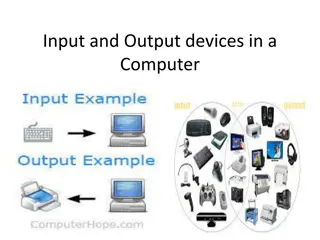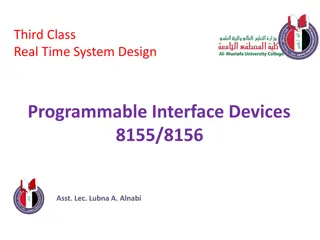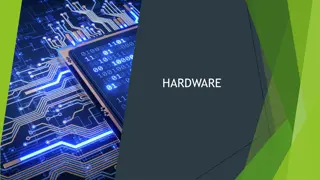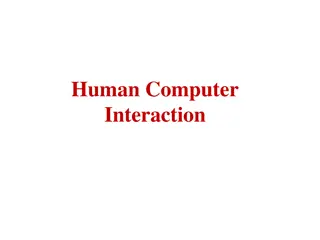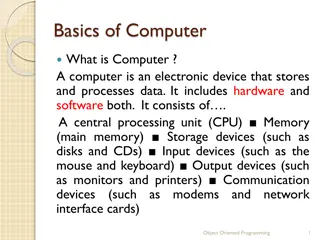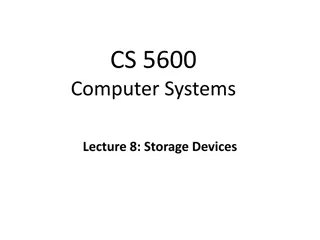Understanding Computer Peripheral Devices: Definition, Examples, and Types
Learn about computer peripheral devices, which enhance a computer system's functionality. Examples include mice, keyboards, monitors, printers, and scanners. These devices can be categorized into input, output, and storage devices, each serving a specific purpose to expand the capabilities of your computer setup.
Download Presentation

Please find below an Image/Link to download the presentation.
The content on the website is provided AS IS for your information and personal use only. It may not be sold, licensed, or shared on other websites without obtaining consent from the author. Download presentation by click this link. If you encounter any issues during the download, it is possible that the publisher has removed the file from their server.
E N D
Presentation Transcript
Computer peripherals Computer Peripheral Devices - Definition, Examples & Types
Computer peripherals continuous A peripheral device connects to a computer system to add functionality. Examples are a mouse, keyboard, monitor, printer and scanner. Learn about the different types of peripheral devices and how they allow you to do more with your computer.
Computer peripherals continuous Definition Say you just bought a new computer and, with excitement, you unpack it and set it all up. The first thing you want to do is print out some photographs of the last family party. So it's time to head back to the store to buy a printer. A printer is known as a peripheral device.
Computer peripherals continuous A computer peripheral is a device that is connected to a computer but is not part of the core computer architecture. The core elements of a computer are the central processing unit, power supply, motherboard and the computer case that contains those three components. Technically speaking, everything else is considered a peripheral device. However, this is a somewhat narrow view, since various other elements are required for a computer to actually function, such as a hard drive and random-access memory (or RAM). Most people use the term peripheral more loosely to refer to a device external to the computer case. You connect the device to the computer to expand the functionality of the system. For example, consider a printer. Once the printer is connected to a computer, you can print out documents. Another way to look at peripheral devices is that they are dependent on the computer system. For example, most printers can't do much on their own, and they only become functional when connected to a computer system.
Types of Peripheral Devices There are many different peripheral devices, but they fall into three general categories: Input devices, such as a mouse and a keyboard Output devices, such as a monitor and a printer Storage devices, such as a hard drive or flash drive
Types of Peripheral Devices continuous Some devices fall into more than one category. Consider a CD-ROM drive; you can use it to read data or music (input), and you can use it to write data to a CD (output). Peripheral devices can be external or internal. For example, a printer is an external device that you connect using a cable, while an optical disc drive is typically located inside the computer case. Internal peripheral devices are also referred to as integrated peripherals. When most people refer to peripherals, they typically mean external ones.
Types of Peripheral Devices continuous The concept of what exactly is 'peripheral' is therefore somewhat fluid. For a desktop computer, a keyboard and a monitor are considered peripherals - you can easily connect and disconnect them and replace them if needed. For a laptop computer, these components are built into the computer system and can't be easily removed.
Types of Peripheral Devices continuous The term 'peripheral' also does not mean it is not essential for the function of the computer. Some devices, such as a printer, can be disconnected and the computer will keep on working just fine. However, remove the monitor of a desktop computer and it becomes pretty much useless.
Examples of Peripheral Devices Here you can see a typical desktop computer system with a number of common peripheral devices. The central processing unit (#2), motherboard (#8) and power supply are the core computer system. Expansion slots (#4) on the motherboard make it possible to connect internal peripherals, such as a video card or sound card (not shown). Other internal peripherals shown are a hard disk drive (#7) and an optical disc drive (#6). External input peripherals are a scanner (#1), display monitor (#10), keyboard (#13) and mouse (#14). External output peripherals are a set of speakers (#9) and a printer (#16). Note that labels 11 and 12 in the figure refer to software and are not peripherals.










